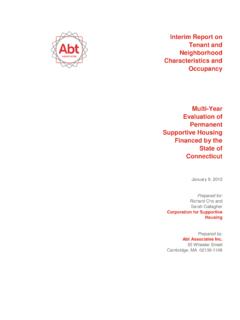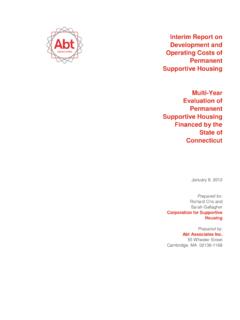Transcription of Considerations for Developing and Managing the …
1 Considerations for Developing and Managing the supportive Services Budget (and Sample Budget) Key Considerations in Budgeting for supportive Services There is no formula for the design and funding of services programs within supportive housing projects. The services plan most typically involves a mix of services delivered on-site and off-site - the specific mix at any given project will be based on tenants needs, agency capacity, partnerships that have been established, resources available within the community, and available funding. supportive housing programs may have services staff located on-site or may have mobile case management programs or Assertive Community Treatment (ACT) teams linked to the housing . Frequently, supportive housing programs have formal linkage agreements with other local organizations, such as drug and alcohol treatment programs, mental health clinics, and employment programs.
2 In all arrangements, the staff helps to ensure that tenants make use of services and amenities in the community. The types of services that comprise the "support" in supportive housing must be responsive to the varied needs of the people who live in the housing , and are often best determined through conversation with the target population(s). Tenants of supportive housing are individuals and families who face complex challenges -- people who have been homeless, and who also have very low incomes and often serious, persistent health issues and/or disabilities or other barriers to housing stability. These challenges may include mental health issues, substance use issues, and HIV/AIDS, and are oftentimes exacerbated by persevering and long-term poverty. Some of the services commonly found on-site or linked to supportive housing are: Case management and services coordination Outreach and engagement Benefits counseling and advocacy Mental health services and treatment Substance use management, harm reduction, abstinence, and relapse support Primary health care and medication management Money management and other independent living skills training and assistance Transportation Education and vocational training Career/job counseling, development and placement Child care programs Youth programs Support/peer support in groups or one-on-one ( , substance use management, abstinence, domestic violence prevention, parenting, mental health, etc.)
3 Activities, classes, workshops and special events to promote relationship-building, mutual aid, and community building_____ Note: This document is included within the supportive Services section of CSH s Toolkit for Developing and Operating supportive housing , which is available at This document has been adapted from the HUD-funded curriculum Financial Management and HUD Compliance, which is available at corporation for supportive housing : Considerations for Developing and Managing the supportive Services Budget March 2006 1 corporation for supportive housing : Considerations for Developing and Managing the supportive Services Budget March 2006 2 The extent of services needs among the tenancy also has major implications for the level and type of supportive services that will be required. If a provider plans to serve a population that may be expected to have considerable service needs ( , formerly homeless people who are dually diagnosed with serious mental illnesses and HIV disease), funding must ensure a staff-to-tenant ratio that will allow for adequate levels of service.
4 Some individuals may need considerable support to remain stable and meet the obligations of tenancy, while others need minimal assistance once stabilized. Some specific service activities can be staff intensive, such as escorting tenants to appointments, medication monitoring, and budgeting assistance. Insufficient staffing can result in crisis-driven programs with high levels of burnout and turnover. If funding is inadequate, both project and program goals may need to be revisited. Primary responsibility for services delivery and services budgeting will also vary from project to project as well. Potential models include: The owner and/or property management agency may provide some services directly, with the balance of the tenants social services needs to be met through referrals to outside providers. Services may be delivered primarily by a third party provider that assumes lead responsibility for service delivery, coordination of services partnerships, and funding.
5 The owner/sponsor of a supportive housing program may contract with a third party provider for services, but the owner/sponsor may have lead responsibility for the services funding. Regardless of the services model, the project owner/sponsor must monitor the services activities closely to be sure that the needs of the tenants are being addressed. How the service provision is structured in a given housing development will help determine many of the financial and budgetary Considerations . Expenses and Revenue in the supportive Services Budget In all cases, it should be an expectation that the project have a supportive services budget that is separate from the housing operations budget for the project and some funding sources will require the clear separation of these budgets. This approach may represent a change of practice for some organizations, such as those that operate transitional housing programs, in which the operating and services costs are often all included within a single budget.
6 As with all budgets, projected expenses must be matched with projected revenues. Expenses On the expense side, the support services budget must include staffing ands service activity levels adequate to assist tenants to live independently in the supportive housing project. The expense portion of a social services budget will generally consist of personnel and other than personnel expenditures. Personnel consists of direct service staff such as counselors, case managers, nurses, etc. and supervisory staff, which can include direct supervisors such as program directors and portions of the overall agency administrative staff such as the executive director and financial manager. Other than personnel services can include supplies and materials directly related to the provision of supportive services as well as general office supplies and support such as office machines, telephone, etc. Other related expenses can include tenant transportation and staff training and recruitment.
7 corporation for supportive housing : Considerations for Developing and Managing the supportive Services Budget March 2006 3 Service activities that might be included in a support services budget include: Case management Life skills training Chemical dependency treatment Mental health rehabilitation Services for the chronically ill, including those living with HIV/AIDS Child care and parenting skills training housing placement assistance Employment and education services Transportation services or subsidies Money Management services Community Building activities and events Training Costs Revenues A major challenge for supportive housing sponsors is to secure resources that can successfully be blended together to provide ongoing support for this range of activities for the diverse tenant population housed in supportive housing . While some supportive housing projects operating budgets generate enough revenue to help pay for a portion of the services costs, revenue for social services costs is generally provided in one or more of the following ways: Fee-for-services arrangements, such as those provided by Medicaid, where providers are reimbursed for specific services, such as attendance at a clinic.
8 Reimbursement is generally according to a fixed rate (per visit or per day, etc.) and occurs only when an eligible tenant receives the service. Through a publicly-funded contract under which the organization provides specified supportive services according to an established budget. For example, this is how HUD pays for supportive services in the McKinney supportive housing Program, or may be how a contract with a local government agency is structured Through fundraising from private sources, such as grants from private foundations or corporations, special events, or revenues generated from businesses operated by the non-profit organization (such as thrift shops). Contracts that fund services according to a set budget have some distinct advantages over fee-for-services arrangements. Contracts are somewhat easier to manage insofar as the income will tend to be more uniform and predictable.
9 Under fee-for-services arrangements, the number of reimbursed visits can be affected by events outside of an organization s control, such as weather, sickness or simple lack of demand. Contracts will also have budgeted and established schedules of personnel expenditures, while fee-for-service arrangements will require that the provider adjust staffing to meet actual demand for services. Social services budgets will generally require a start-up phase of early operations. During this phase, the organization will have to recruit and train staff, secure space and facilities to provide services, and engage in outreach and screening of potential participants. Fee-for-services payment corporation for supportive housing : Considerations for Developing and Managing the supportive Services Budget March 2006 4 arrangements generally do not cover these start-up costs, while contracts and grant agreements arrangements often do for example, HUD permits start-up costs to be paid out of McKinney supportive housing Program grants.
10 If the primary reimbursement source does not cover start-up expenses, such costs will have to be paid for will then have to be funded through grants or by loans that will be repaid based on the fee-for-service revenue generated. Note: A Sample supportive Services Budget is attached. This sample budget should only be used as a reference to help guide the development of a services budget, not as a predictor of actual costs or revenues. Key Consideration for Fund Accounting for Program Services Funds for social services may come from many varied sources and may fund several different programs. Categorizing financial information by program can help program managers identify the costs associated with that specific program. Additionally, accounting activities can be grouped by funding source in the accounting system. This allows management staff to see how the funds are being spent. Fund accounting software allows for this kind of accounting - however, more complex accounting software costs more.








